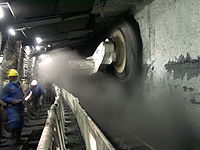
Photo from wikipedia
Most attention in quantifying carbon dioxide (CO2) emissions from tropical peatlands has been on large-scale plantations (industrial timber, oil palm (Elaeis guinensis)), differing in drainage and land-use practices from those… Click to show full abstract
Most attention in quantifying carbon dioxide (CO2) emissions from tropical peatlands has been on large-scale plantations (industrial timber, oil palm (Elaeis guinensis)), differing in drainage and land-use practices from those of smallholder farms. We measured subsidence and changes in bulk density and carbon organic content to calculate CO2 emissions over 2.5 years in a remnant logged-over forest and four dominant smallholder land-use types in Tanjung Jabung Barat District, Jambi Province, Sumatra, Indonesia: (1) simple rubber (Hevea brasiliensis) agroforest (> 30 years), (2) mixed coconut (Cocos nucifera) and coffee gardens (Coffea liberica) (> 40 years), (3) mixed betel nut (Areca catechu) and coffee gardens (> 20 years), and (4) oil palm plantation (1 year). We quantified changes in microtopography for each site for greater accuracy of subsidence estimates and tested the effects of nitrogen and phosphorus application. All sites had a fibric type of peat with depths of 50 to > 100 cm. A recently established oil palm had the highest rate of peat subsidence and emission (4.7 cm year−1 or 121 Mg CO2 ha−1 year−1) while the remnant forest had the lowest (1.8 cm year−1 or 40 Mg CO2 ha−1 year−1). Other land-use types subsided by 2–3 cm year−1, emitting 70–85 Mg CO2 ha−1 year−1. Fertilizer application did not have a consistent effect on inferred emissions. Additional emissions in the first years after drainage, despite groundwater tables of 40 cm, were of the order of belowground biomass of peat forest. Despite maintaining higher water tables, smallholder landscapes have CO2 emissions close to, but above, current IPCC defaults.
Journal Title: Mitigation and Adaptation Strategies for Global Change
Year Published: 2018
Link to full text (if available)
Share on Social Media: Sign Up to like & get
recommendations!